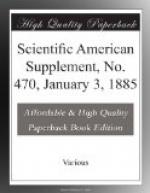With this engine a speed of 5,000 revolutions per minute is easily attainable, while, as a matter of fact and curiosity, a speed of 8,000 revolutions per minute has been obtained. An engine of this class was run at the Illinois Inter-State Exposition at Chicago for six weeks at a uniform speed of 1,050 revolutions per minute, furnishing the power for twenty-three electric arc lights, with a steam pressure not exceeding fifty-five pounds per square inch, and cutting off at from one-tenth to one-sixth of the stroke. It was taking steam from a large main-pipe, so there was no opportunity for an exact test of the amount of fuel used, but from a careful mathematical calculation it must have been developing one horse-power from three pounds of coal.
The inventor claims that, as his engine works the steam expansively, even better results would have been obtained had the engine been furnished steam at 100 pounds per square inch.
[Illustration: Figs. 2 and 3.—DETAILS OF HARRINGTON ENGINE.]
The Harrington Rotary Engine Company, 123 Clinton Street, Chicago, are the owners and manufacturers.
* * * * *
In a can of peas sold in Liverpool recently the public analyst found two grains of crystallized sulphate of copper, a quantity sufficient to injuriously affect human health. The defendant urged that the public insisted upon having green peas; and that artificial means had to be resorted to to secure the required color.
* * * * *
TESTING CAR VARNISHES.
By D.D. ROBERTSON.
At the Master Car-Painters’ Convention, D.D. Robertson, of the Michigan Central, read the following paper on the best method of testing varnishes to secure the most satisfactory results as to their durability, giving practical suggestions as to the time a car may safely remain in the service before being taken in for revarnishing:
The subject which the association has assigned to me for this convention has always been regarded as important. There is no branch of the business which gives the painter more anxiety than the varnishing department. It is more susceptible to an endless variety of difficulties, and therefore needs more close and careful attention, than all other branches put together, and even with all the research and practical experience which has been given to the subject we are yet far from coming to a definite conclusion as to the causes of many of the unfavorable results.
Beauty and durability are what we aim at in the paint shop, and from my experience in varnish work we may have beauty without durability, but we have rarely durability without beauty, so that the fewer defects of any kind in our work caused by inferior material, inferior workmanship, or any other cause, it is more likely to be durable, and ought, therefore, to possess beauty. There are certain qualifications absolutely




